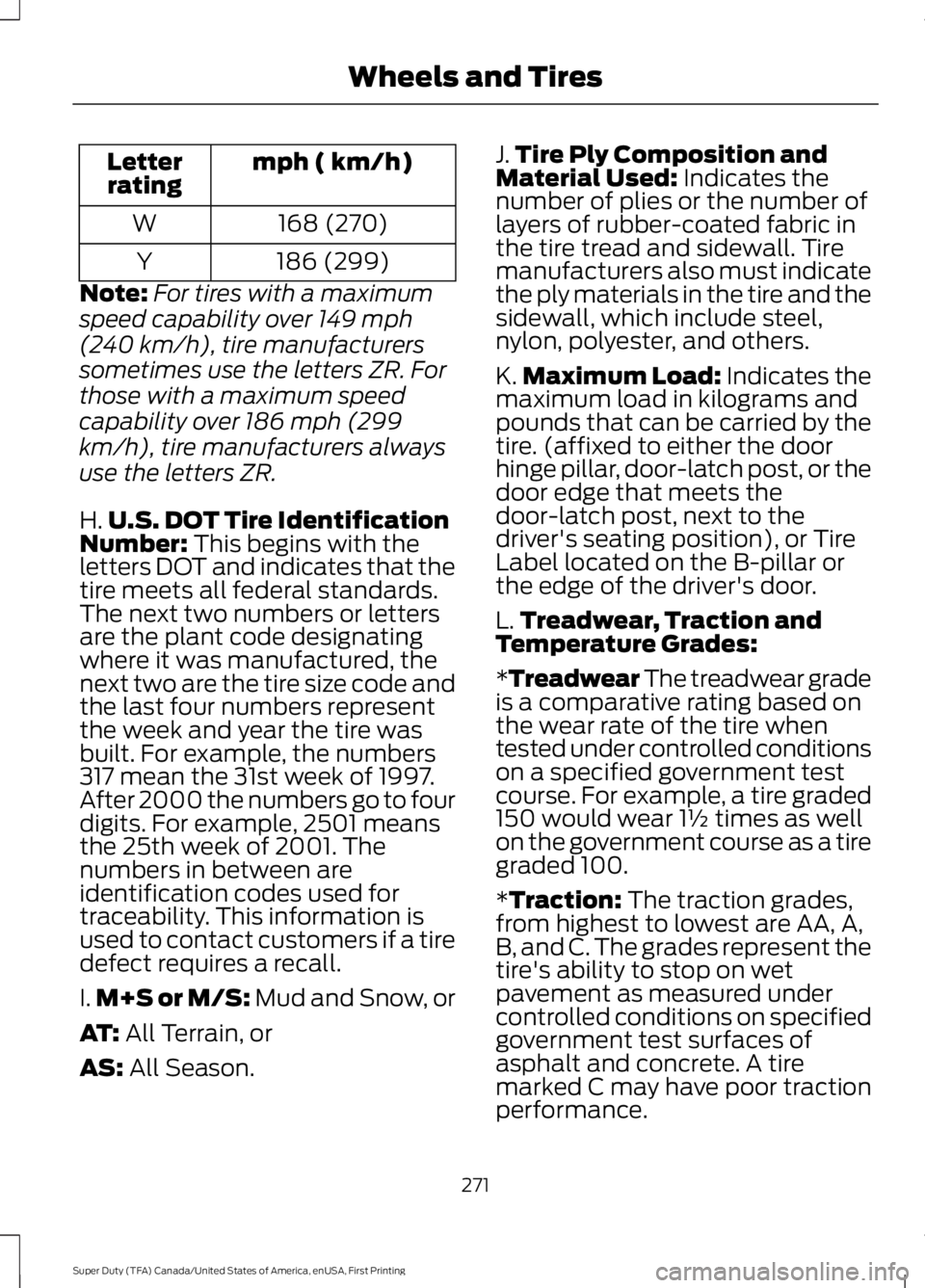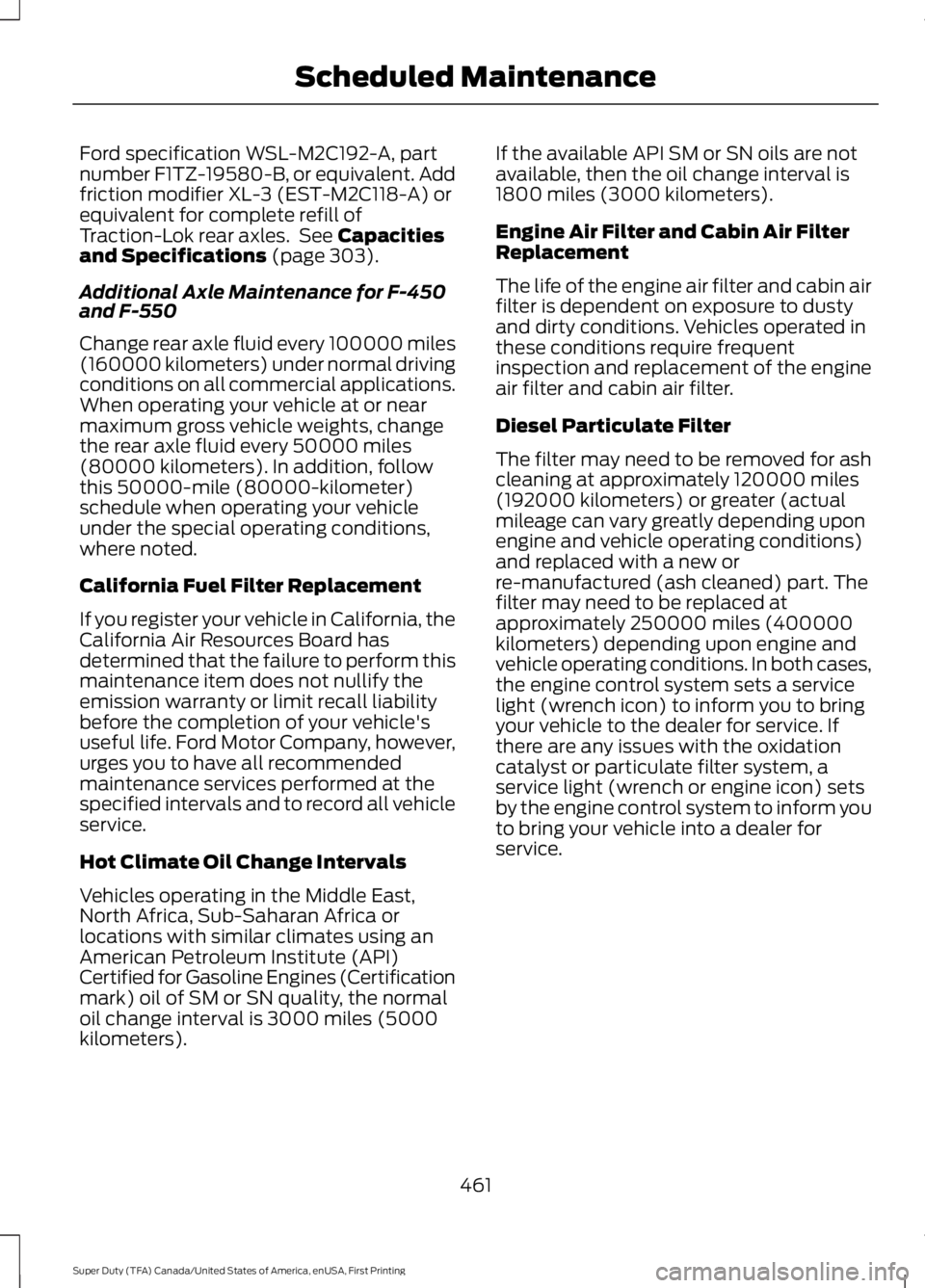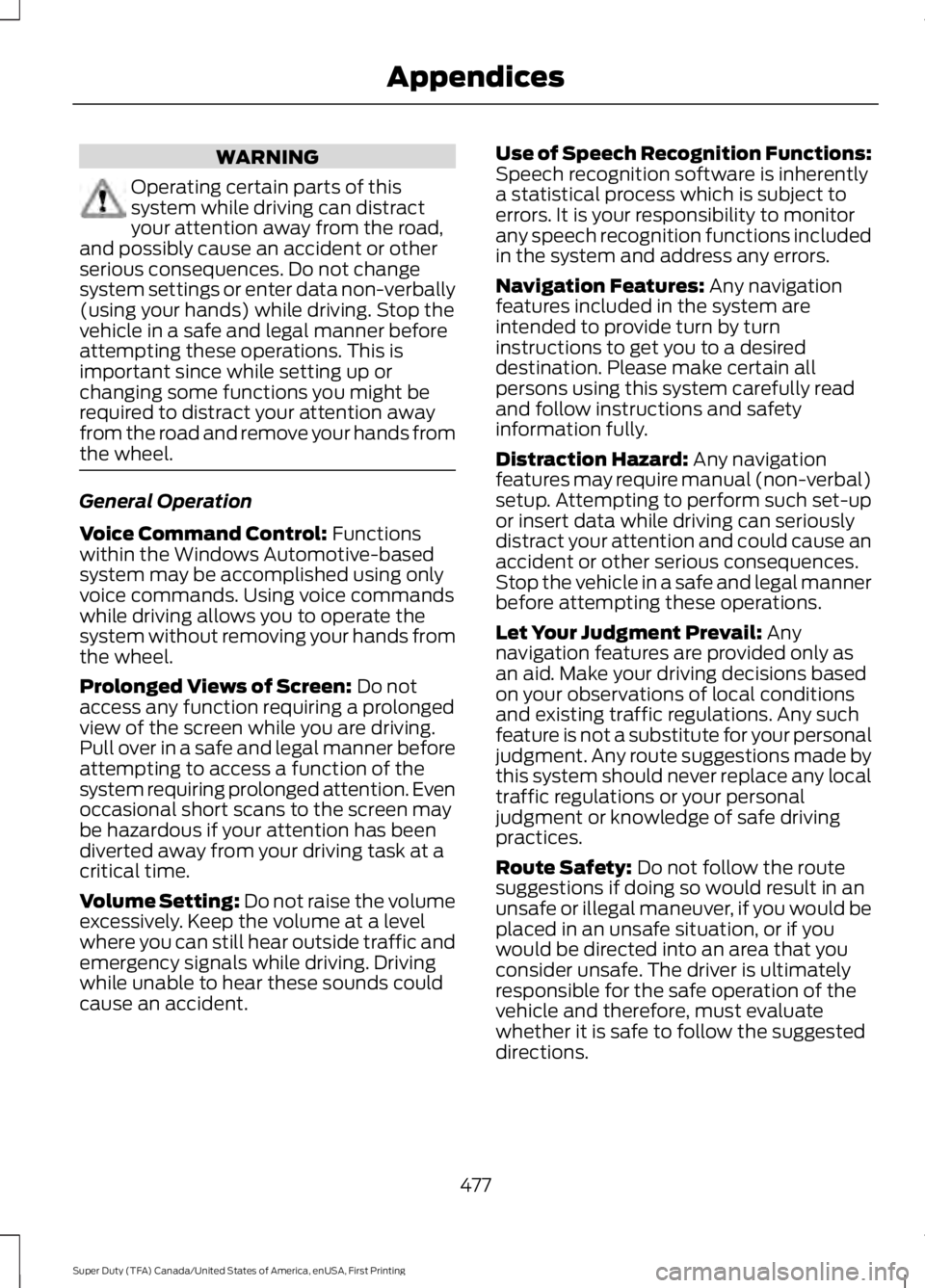2016 FORD F250 traction control
[x] Cancel search: traction controlPage 271 of 507

The traction grades, from highest
to lowest are AA, A, B, and C. The
grades represent the tire
’s ability
to stop on wet pavement as
measured under controlled
conditions on specified
government test surfaces of
asphalt and concrete. A tire
marked C may have poor traction
performance.
Temperature A B C WARNING
The temperature grade for
this tire is established for a
tire that is properly inflated and
not overloaded. Excessive speed,
underinflation, or excessive
loading, either separately or in
combination, can cause heat
buildup and possible tire failure. The temperature grades are A
(the highest), B and C,
representing the tire
’s resistance
to the generation of heat and its
ability to dissipate heat when
tested under controlled conditions
on a specified indoor laboratory
test wheel. Sustained high
temperature can cause the
material of the tire to degenerate
and reduce tire life, and excessive
temperature can lead to sudden
tire failure. The grade C
corresponds to a level of
performance which all passenger
car tires must meet under the Federal Motor Vehicle Safety
Standard No. 139. Grades B and A
represent higher levels of
performance on the laboratory
test wheel than the minimum
required by law.
Glossary of Tire Terminology
*Tire label: A label showing the
original equipment tire sizes,
recommended inflation pressure
and the maximum weight the
vehicle can carry.
*
Tire Identification Number
(TIN): A number on the sidewall
of each tire providing information
about the tire brand and
manufacturing plant, tire size and
date of manufacture. Also referred
to as DOT code.
*
Inflation pressure: A measure
of the amount of air in a tire.
*
Standard load: A class of
P-metric or Metric tires designed
to carry a maximum load at set
pressure. For example: For
P-metric tires
35 psi (2.4 bar) or
36 psi (2.5 bar) depending on tire
size and for Metric tires
36 psi
(2.5 bar). Increasing the inflation
pressure beyond this pressure will
not increase the tire ’s load
carrying capability.
*
Extra load: A class of P-metric
or Metric tires designed to carry a
heavier maximum load at
42 psi
(2.9 bar). Increasing the inflation
pressure beyond this pressure will
not increase the tire ’s load
carrying capability.
268
Super Duty (TFA) Canada/United States of America, enUSA, First Printing Wheels and Tires
Page 274 of 507

mph ( km/h)
Letter
rating
168 (270)
W
186 (299)
Y
Note: For tires with a maximum
speed capability over 149 mph
(240 km/h), tire manufacturers
sometimes use the letters ZR. For
those with a maximum speed
capability over 186 mph (299
km/h), tire manufacturers always
use the letters ZR.
H. U.S. DOT Tire Identification
Number: This begins with the
letters DOT and indicates that the
tire meets all federal standards.
The next two numbers or letters
are the plant code designating
where it was manufactured, the
next two are the tire size code and
the last four numbers represent
the week and year the tire was
built. For example, the numbers
317 mean the 31st week of 1997.
After 2000 the numbers go to four
digits. For example, 2501 means
the 25th week of 2001. The
numbers in between are
identification codes used for
traceability. This information is
used to contact customers if a tire
defect requires a recall.
I. M+S or M/S:
Mud and Snow, or
AT:
All Terrain, or
AS:
All Season. J.
Tire Ply Composition and
Material Used:
Indicates the
number of plies or the number of
layers of rubber-coated fabric in
the tire tread and sidewall. Tire
manufacturers also must indicate
the ply materials in the tire and the
sidewall, which include steel,
nylon, polyester, and others.
K. Maximum Load: Indicates the
maximum load in kilograms and
pounds that can be carried by the
tire. (affixed to either the door
hinge pillar, door-latch post, or the
door edge that meets the
door-latch post, next to the
driver's seating position), or Tire
Label located on the B-pillar or
the edge of the driver's door.
L. Treadwear, Traction and
Temperature Grades:
*Treadwear The treadwear grade
is a comparative rating based on
the wear rate of the tire when
tested under controlled conditions
on a specified government test
course. For example, a tire graded
150 would wear 1½ times as well
on the government course as a tire
graded 100.
*
Traction: The traction grades,
from highest to lowest are AA, A,
B, and C. The grades represent the
tire's ability to stop on wet
pavement as measured under
controlled conditions on specified
government test surfaces of
asphalt and concrete. A tire
marked C may have poor traction
performance.
271
Super Duty (TFA) Canada/United States of America, enUSA, First Printing Wheels and Tires
Page 287 of 507

If your vehicle is equipped with
dual rear wheels it is
recommended that the front and
rear tires (in pairs) be rotated only
side to side. We do not
recommend splitting up the dual
rear wheels. Rotate them side to
side as a set. After tire rotation,
inflation pressures must be
adjusted for the tires new
positions in accordance with
vehicle requirements.
USING SNOW CHAINS
WARNING
Snow tires must be the same size,
load index, speed rating as those
originally provided by Ford. Use of
any tire or wheel not recommended by
Ford can affect the safety and
performance of your vehicle, which could
result in an increased risk of loss of vehicle
control, vehicle rollover, personal injury and
death. Additionally, the use of
non-recommended tires and wheels could
cause steering, suspension, axle, transfer
case or power transfer unit failure. Note:
Do not use snow chains on vehicles
with 20 inch wheels and tires.
The tires on your vehicle have all-weather
treads to provide traction in rain and snow.
However, in some climates, you may need
to use snow tires and cables. If you need
to use cables, it is recommended that steel
wheels (of the same size and
specifications) be used, as cables may chip
aluminum wheels.
Note: The suspension insulation and
bumpers will help prevent vehicle damage.
Do not remove these components from your
vehicle when using snow tires and chains. Follow these guidelines when using snow
tires and chains:
•
If possible, avoid fully loading your
vehicle
• Use only SAE Class S chains.
• Install chains securely, verifying that
the chains do not touch any wiring,
brake lines or fuel lines.
• Drive cautiously. If you hear the chains
rub or bang against your vehicle, stop
and retighten the chains. If this does
not work, remove the chains to prevent
damage to your vehicle.
• Remove the tire chains when they are
no longer needed. Do not use tire
chains on dry roads.
If you have any questions regarding snow
chains or cables, please contact your
authorized dealer.
TIRE PRESSURE MONITORING
SYSTEM WARNING
The tire pressure monitoring system
is not a substitute for manually
checking the tire pressure. The tire
pressure should be checked periodically
(at least monthly) using a tire pressure
gauge. Failure to properly maintain your
tire pressure could increase the risk of tire
failure, loss of control, vehicle rollover and
personal injury. 284
Super Duty (TFA) Canada/United States of America, enUSA, First Printing Wheels and Tires
Page 464 of 507

Ford specification WSL-M2C192-A, part
number F1TZ-19580-B, or equivalent. Add
friction modifier XL-3 (EST-M2C118-A) or
equivalent for complete refill of
Traction-Lok rear axles. See Capacities
and Specifications (page 303).
Additional Axle Maintenance for F-450
and F-550
Change rear axle fluid every 100000 miles
(160000 kilometers) under normal driving
conditions on all commercial applications.
When operating your vehicle at or near
maximum gross vehicle weights, change
the rear axle fluid every 50000 miles
(80000 kilometers). In addition, follow
this 50000-mile (80000-kilometer)
schedule when operating your vehicle
under the special operating conditions,
where noted.
California Fuel Filter Replacement
If you register your vehicle in California, the
California Air Resources Board has
determined that the failure to perform this
maintenance item does not nullify the
emission warranty or limit recall liability
before the completion of your vehicle's
useful life. Ford Motor Company, however,
urges you to have all recommended
maintenance services performed at the
specified intervals and to record all vehicle
service.
Hot Climate Oil Change Intervals
Vehicles operating in the Middle East,
North Africa, Sub-Saharan Africa or
locations with similar climates using an
American Petroleum Institute (API)
Certified for Gasoline Engines (Certification
mark) oil of SM or SN quality, the normal
oil change interval is 3000 miles (5000
kilometers). If the available API SM or SN oils are not
available, then the oil change interval is
1800 miles (3000 kilometers).
Engine Air Filter and Cabin Air Filter
Replacement
The life of the engine air filter and cabin air
filter is dependent on exposure to dusty
and dirty conditions. Vehicles operated in
these conditions require frequent
inspection and replacement of the engine
air filter and cabin air filter.
Diesel Particulate Filter
The filter may need to be removed for ash
cleaning at approximately 120000 miles
(192000 kilometers) or greater (actual
mileage can vary greatly depending upon
engine and vehicle operating conditions)
and replaced with a new or
re-manufactured (ash cleaned) part. The
filter may need to be replaced at
approximately 250000 miles (400000
kilometers) depending upon engine and
vehicle operating conditions. In both cases,
the engine control system sets a service
light (wrench icon) to inform you to bring
your vehicle to the dealer for service. If
there are any issues with the oxidation
catalyst or particulate filter system, a
service light (wrench or engine icon) sets
by the engine control system to inform you
to bring your vehicle into a dealer for
service.
461
Super Duty (TFA) Canada/United States of America, enUSA, First Printing Scheduled Maintenance
Page 480 of 507

WARNING
Operating certain parts of this
system while driving can distract
your attention away from the road,
and possibly cause an accident or other
serious consequences. Do not change
system settings or enter data non-verbally
(using your hands) while driving. Stop the
vehicle in a safe and legal manner before
attempting these operations. This is
important since while setting up or
changing some functions you might be
required to distract your attention away
from the road and remove your hands from
the wheel. General Operation
Voice Command Control: Functions
within the Windows Automotive-based
system may be accomplished using only
voice commands. Using voice commands
while driving allows you to operate the
system without removing your hands from
the wheel.
Prolonged Views of Screen:
Do not
access any function requiring a prolonged
view of the screen while you are driving.
Pull over in a safe and legal manner before
attempting to access a function of the
system requiring prolonged attention. Even
occasional short scans to the screen may
be hazardous if your attention has been
diverted away from your driving task at a
critical time.
Volume Setting: Do not raise the volume
excessively. Keep the volume at a level
where you can still hear outside traffic and
emergency signals while driving. Driving
while unable to hear these sounds could
cause an accident. Use of Speech Recognition Functions:
Speech recognition software is inherently
a statistical process which is subject to
errors. It is your responsibility to monitor
any speech recognition functions included
in the system and address any errors.
Navigation Features:
Any navigation
features included in the system are
intended to provide turn by turn
instructions to get you to a desired
destination. Please make certain all
persons using this system carefully read
and follow instructions and safety
information fully.
Distraction Hazard:
Any navigation
features may require manual (non-verbal)
setup. Attempting to perform such set-up
or insert data while driving can seriously
distract your attention and could cause an
accident or other serious consequences.
Stop the vehicle in a safe and legal manner
before attempting these operations.
Let Your Judgment Prevail:
Any
navigation features are provided only as
an aid. Make your driving decisions based
on your observations of local conditions
and existing traffic regulations. Any such
feature is not a substitute for your personal
judgment. Any route suggestions made by
this system should never replace any local
traffic regulations or your personal
judgment or knowledge of safe driving
practices.
Route Safety:
Do not follow the route
suggestions if doing so would result in an
unsafe or illegal maneuver, if you would be
placed in an unsafe situation, or if you
would be directed into an area that you
consider unsafe. The driver is ultimately
responsible for the safe operation of the
vehicle and therefore, must evaluate
whether it is safe to follow the suggested
directions.
477
Super Duty (TFA) Canada/United States of America, enUSA, First Printing Appendices
Page 505 of 507

Snowplowing................................................209
Engine temperature while plowing..............210
Installing the Snowplow................................. 209
Operating the Vehicle with the Snowplow Attached........................................................... 210
Snowplowing with your Airbag Equipped Vehicle............................................................... 210
Transmission operation while plowing............................................................... 211
Special Notices................................................12 New Vehicle Limited Warranty......................... 12
On-board Diagnostics (OBD-II)....................... 12
Special Instructions.............................................. 12
Using your Vehicle as an Ambulance.............12
Using your Vehicle as a Stationary Power Source................................................................... 13
Using your Vehicle With a Snowplow............12
Special Operating Conditions Scheduled Maintenance...............................................457
6.2L and 6.8L Gasoline Engines................... 457
6.7L Diesel Engine............................................. 460
Exceptions........................................................... 460
Speed Control See: Cruise Control............................................ 183
Stability Control.............................................174
Principle of Operation....................................... 174
Starter Switch See: Ignition Switch........................................... 140
Starting a Gasoline Engine.........................141 Cold Weather Starting (Flexible Fuel
Vehicles Only).................................................. 141
Failure to Start...................................................... 141
Guarding Against Exhaust Fumes................142
Important Ventilating Information...............142
Stopping the Engine When Your Vehicle is Moving................................................................. 141
Stopping the Engine When Your Vehicle is Stationary.......................................................... 141
Starting and Stopping the Engine.........140 General Information.......................................... 140
Steering............................................................184
Steering Wheel...............................................66
Storage Compartments
.............................139
Sunroof See: Moonroof...................................................... 80
Sun Visors
.........................................................80
Illuminated Vanity Mirror.................................. 80
Slide-on-rod.......................................................... 80Supplementary Restraints System..........37
Principle of Operation......................................... 37
Symbols Glossary
.............................................7
SYNC™ Applications and Services........................................................346
911 Assist............................................................... 346
SYNC Services: Traffic, Directions & Information (TDI) (If Equipped, United
States Only)................................................... 350
Vehicle Health Report (If Equipped, United States Only)................................................... 348
SYNC™ AppLink ™
.....................................354
SYNC Mobile Apps............................................ 354
SYNC™............................................................329 General Information......................................... 329
SYNC™ Troubleshooting
.........................365
T
Tailgate Lock...................................................60
Tailgate Step
.....................................................61
Closing the step..................................................... 61
Opening the step................................................... 61
Tailgate..............................................................60
Technical Specifications See: Capacities and Specifications............303
Terrain Response
...........................................177
Principle of Operation........................................ 177
The Better Business Bureau (BBB) Auto Line Program (U.S. Only)........................219
Tire Care
..........................................................267
Glossary of Tire Terminology........................ 268
Information About Uniform Tire Quality Grading.............................................................. 267
Information Contained on the Tire Sidewall........................................................... 269
Temperature A B C............................................ 268
Traction AA A B C............................................... 267
Treadwear............................................................. 267
Tire Pressure Monitoring System..........284 Changing Tires With a Tire Pressure
Monitoring System....................................... 286
Understanding Your Tire Pressure Monitoring System ...................................... 286
Tires See: Wheels and Tires..................................... 264
Towing a Trailer.............................................192 Load Placement.................................................. 192
502
Super Duty (TFA) Canada/United States of America, enUSA, First Printing Index
Page 506 of 507

Towing Points...............................................204
Towing the Vehicle on Four Wheels.........................................................206
Emergency Towing........................................... 206
Recreational Towing........................................ 206
Towing..............................................................192
Traction Control.............................................172 Principle of Operation........................................ 172
Trailer Sway Control
....................................193
Transfer Case Fluid Check........................243
Transmission Code Designation...........306
Transmission...................................................151
Transmission See: Transmission............................................... 151
Transporting the Vehicle..........................205
U
Under Hood Overview - 6.2L...................233
Under Hood Overview - 6.8L..................234
Universal Garage Door Opener...............129 CAR2U® Home Automation System..........129
HomeLink Wireless Control System............132
USB Port
.........................................................328
Using Cruise Control....................................183
Switching Cruise Control Off......................... 183
Switching Cruise Control On.......................... 183
Using Four-Wheel Drive
.............................158
4WD Indicator Lights........................................ 159
Driving Off-Road With Truck and Utility Vehicles............................................................. 162
Electronic Shift-On-the-Fly (ESOF) 4WD system............................................................... 158
How Your Vehicle Differs From Other Vehicles............................................................. 162
Manual Shift On Stop (MSOS) 4WD system............................................................... 158
Using a Manual Shift On Stop (MSOS) 4WD system.................................................... 159
Using the Electronic Shift on the Fly 4WD system................................................................ 161
Using Hill Descent Control.........................177 Hill descent modes............................................. 177
Using MyKey With Remote Start Systems..........................................................55
Using Snow Chains
.....................................284 Using Stability Control................................174
AdvanceTrac® with Roll Stability Control ™
(RSC®)............................................................... 174
Using SYNC™ With Your Media Player............................................................355
Accessing Your Play Menu............................. 360
Connecting Your Digital Media Player to the USB Port........................................................... 355
Media Menu Features...................................... 358
Media Voice Commands................................. 357
System Settings................................................. 362
What's Playing?................................................. 357
Using SYNC™ With Your Phone............334 Accessing Features Through the Phone
Menu.................................................................. 338
Accessing Your Phone Settings.................... 342
Making a Call....................................................... 337
Pairing a Cell Phone for the First Time................................................................... 334
Pairing Subsequent Cell Phones.................335
Phone Options during an Active Call..........337
Phone Voice Commands................................ 335
Receiving Calls.................................................... 337
System Settings................................................. 343
Text Messaging.................................................. 340
Using Traction Control
................................172
System Indicator Lights and
Messages........................................................... 173
Using Voice Recognition............................331 Initiating a Voice Session................................. 331
System Interaction and Feedback..............332
Utilizing the Mediation/Arbitration Program (Canada Only)
.........................219
V
Vehicle Care...................................................256 General Information......................................... 256
Vehicle Certification Label
......................306
Vehicle Identification Number...............305
503
Super Duty (TFA) Canada/United States of America, enUSA, First Printing Index